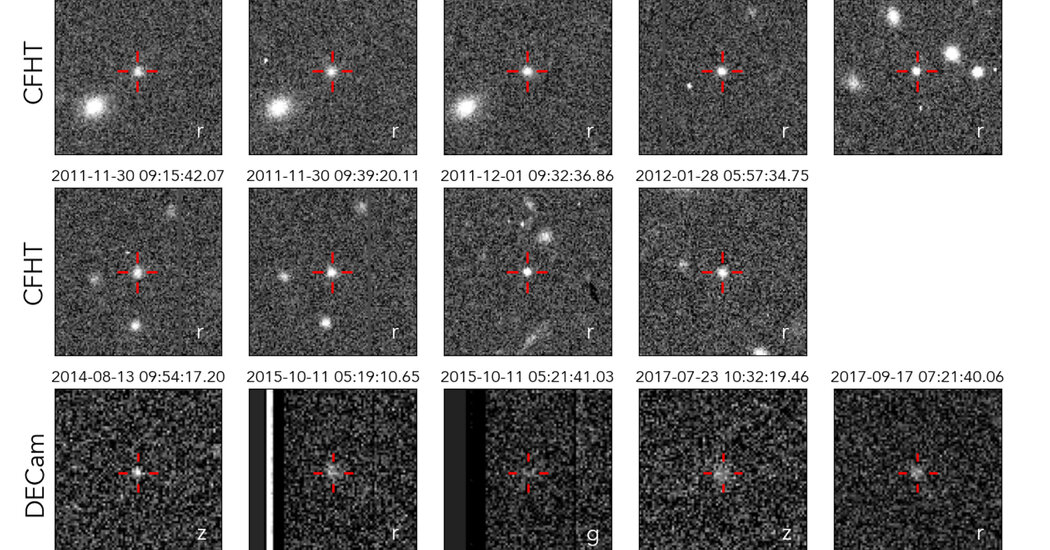A sizable world has been found in a part of the solar system that astronomers once thought to be empty. It probably qualifies as a dwarf planet, the same classification as Pluto.
Temporarily named 2017 OF201, it takes more than 24,000 years to travel around the sun just once along a highly elliptical orbit, coming as close as 4.2 billion miles and moving as far out as 151 billion miles. (Neptune is just 2.8 billion miles from the sun.)
And 2017 OF201 may have implications for the hypothesis of an undiscovered planet, nicknamed Planet Nine, in the outer reaches of the solar system.
“We discovered a very large trans-Neptunian object in a very exotic orbit,” said Sihao Cheng, a researcher at the Institute for Advanced Study in Princeton, N.J.
The findings, by Dr. Cheng and two Princeton University graduate students, Jiaxuan Li and Eritas Yang, have not yet been published in a peer-reviewed journal.
Estimated to be about 430 miles wide, 2017 OF201 is very likely to be massive enough for its gravity to pull it into a round shape — the criterion for a dwarf planet. The International Astronomical Union created this category in 2006 when it dropped Pluto from the roster of full-fledged planets.
Like Pluto, 2017 OF201 would not meet the threshold to be called a planet because it is not large enough to have “cleared its neighborhood” of other objects near its orbit.
Dr. Cheng became intrigued by the far out region of the solar system after listening to a talk last year by Mike Brown, an astronomer at the California Institute of Technology. In 2005, Dr. Brown discovered Eris, a Pluto-size world beyond Pluto, which set off a series of events leading to Pluto’s demotion.
The astronomical union has only officially recognized five dwarf planets: Pluto, Eris, the large asteroid Ceres and two other objects beyond Neptune, Haumea and Makemake. But according to Dr. Brown, more than 100 other solar system bodies are likely to qualify, although definitive evidence of roundness is unlikely anytime soon.
Dr. Brown also discovered Sedna, a surprisingly large world — more than 700 miles wide — that orbits the sun far beyond the orbit of Neptune. Over the years, more of these worlds, which are sometimes called extreme trans-Neptunian objects, have been identified.
Dr. Brown and Konstantin Batygin, also of Caltech, have asserted that the orbits seem to align in a particular direction, and have said that points to the gravitational tugging of an unseen planet several times larger than Earth — Planet Nine. But so far, searches for Planet Nine have come up empty.
Dr. Cheng decided to search, too. His co-author Mr. Li suggested delving into an archive of images taken by the Blanco telescope in Chile.
Dr. Cheng spent half a year writing a computer program to recognize that dots in different images taken months apart were actually the same object that had moved in the sky.
“The motion of these objects on the sky follow a particular pattern,” Dr. Cheng said. But the permutation of possible dots, which could also be closer objects like asteroids or random noise in the sensors, was daunting. He came up with a clever algorithm.
“It’s still a lot of computation,” Dr. Cheng said. “Just from impossible to possible.”
While their search also failed to find Planet Nine, the dots connected for 2017 OF201.
The researchers subsequently found nine more sightings in images taken years earlier by the Canada-France-Hawaii Telescope in Hawaii. That allowed a precise calculation of the orbit. The last time 2017 OF201 made its closest approach to the sun was in 1930, the year that Pluto was discovered. It will not be that close again until around the year 26186.
From its brightness and an assumption of the darkness of the surface, the researchers estimated its size.
Dr. Cheng originally calculated that the orbit roughly fit with the alignment proposed by Dr. Brown and Dr. Batygin. But after Mr. Li pointed out a mistake in Dr. Cheng’s calculations, they determined that the elliptical orbit was oriented in a different direction.
“And then we realized the orbit of this thing looks kind of weird,” Mr. Li said. “We started to realize, Can we say something about the history of this object and also maybe its implication on the existence of a Planet Nine?”
Numerical simulations by Ms. Yang, the other author of the paper, looked at how the orbit of 2017 OF201 could have changed over the 4.5 billion-year history of the solar system, and how it might change in the years to come.
Ms. Yang found that its orbit would remain stable for the next billion years or so — if there were no Planet Nine. But a Planet Nine would nudge the closest part of 2017 OF201’s trajectory inward until Neptune flung it out of the solar system.
That would happen pretty quickly, within about 100 million years. If Planet Nine were there, 2017 OF201 should not be there. Because 2017 OF201 is there, that could be an argument that Planet Nine is not.
But Ms. Yang’s simulations only considered one possible orbit for Planet Nine. It is also possible that 2017 OF201 was pushed into its current orbit in the fairly recent cosmological past.
“It doesn’t mean too much, actually, because the object is unstable,” Dr. Batygin said.
Dr. Cheng said he still thought Planet Nine was possible. But Dr. Li said that when he plotted the orbit, “I thought, OK, this kills Planet Nine.”
He agreed that the simulations were not definitive, but joked, “It’s 49 percent killed.”
Ms. Yang said she was neutral on Planet Nine’s existence. “I’m just excited that there’s lots more to be worked on this,” she said.
Another new study by researchers at Rice University and the Planetary Science Institute suggests how something as big as Planet Nine could have ended up so far from the sun.
Such “wide orbit” planets have been spotted around other stars, and so it would not be inconceivable that the solar system had one too, said Andre Izidoro, a planetary astrophysicist at Rice and lead author of the study.
As a planetary system forms around a star, the gravitational jostlings of the planets can scatter some of them into highly elliptical orbits and eventually into deep space.
However, stars like the sun are typically born in dense star clusters, and another passing star can nudge a planet that would otherwise be flung out of the system into a stable orbit that no longer comes close to the other planets.
“The passing star essentially saves the planet,” Dr. Izidoro said.
Kenneth Chang, a science reporter at The Times, covers NASA and the solar system, and research closer to Earth.
The post Scientists Say They’ve Found a Dwarf Planet Very Far From the Sun appeared first on New York Times.




